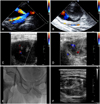Abstract
A femoral artery pseudoaneurysm (FAP) is one of the most troublesome complications following invasive procedures related to the femoral arterial access. Post-procedure FAP rarely occurs; however, its occurrence tends to increase with the more frequently antiplatelet agents, anticoagulants, and larger-sized catheter used for interventional procedures. Traditionally, surgical repair has been considered as the standard treatment modality for FAP; however, less invasive methods currently exist such as blind manual or ultrasound-guided compression repair (UGCR) as well as percutaneous thrombin injection, both of which have replaced the need for surgery. We report a case of a giant pseudoaneurysm in a femoral artery, which had developed as a complication of stenting in a patient with carotid artery stenosis and ischemic heart disease, and was subsequently successfully treated using percutaneous thrombin injection.
Iatrogenic femoral artery pseudoaneurysm (IFAP) is an undesirable complication of invasive procedures involving a femoral arterial puncture site. The incidence of femoral artery pseudoaneurysm (FAP) varies from 0.05-8% following interventional procedures.1) Ultrasoundguided compression repair (UGCR) has replaced surgical repair of FAP as the first-line treatment in many hospitals.2) Recently percutaneous thrombin injection has also become popular. Here, we report the successful treatment of giant FAP, obliterated by percutaneous thrombin injection after failure of UGCR in a case of carotid artery stenting.
A 59-year-old man was referred due to a pulsatile, tender mass in the right groin as well as a swollen leg. Seventeen days earlier, he had undergone left carotid artery stenting as part of the treatment for a recent stroke via the right femoral artery. Ultrasound (US) confirmed a right FAP (Fig. 1A), sized 55×30 mm, and compression on the pseudoaneurysm neck was applied using a US probe until the flow through the neck was stopped. Repeated UGCR was unsuccessful resulting in enlargement of the FAP and discomfort to the patient which was presented as vasovagal syncope (Fig. 1B). Following this, thrombin (1,800 IU) was injected into the cavity of the pseudoaneurysm using US guidance (Fig. 1C and D). To avoid distal migration of the thrombin, we occluded the right femoral artery intermittently during thrombin injection using an angioplasty balloon (Fig. 1E). The pseudoaneurysm was thrombosed following the procedure. A one day post-operative US revealed the clotted cavity of the pseudoaneurysm with a small sized subcutaneous hematoma in the right groin area (Fig. 1F). He was discharged without complication or recurrence of pseudoaneurysm.
IFAP is one of the complications related to interventional procedures at the femoral artery access site. Complications of pseudoaneurysm include rupture, distal embolization, local pain, neuropathy, and limb ischemia.3) Traditionally, surgical repair has been the main treatment for FAP, especially when pseudoaneurysm larger than 4 cm is indicated or when anticoagulation or GPIIbIIIa inhibitors are extensively used during the procedure.4) However, it has been reported that surgical complications occurred in 71% of cases including the need for transfusion (53%), infection (19%), wound dehiscence (12.7%) and mortality (3.8%).5) Recently, successful closures of pseudoaneurysms using nonsurgical techniques have been reported in many institutes. In particular, the success rate of UGCR has been reported as 71-99%.1) However, there are disadvantages of UGCR including long procedure times, discomfort to patients, and a recurrence rate as high as 25-35% in cases receiving anticoagulant therapy. In addition, UGCR was shown to be less effective in cases of FAP larger than 3-4 cm.3)
On the other hand, US-guided thrombin injection is non-invasive, cost-effective, and has an advantage of decreasing the risk of post surgery morbidity. Overall success rates have ranged from 91% to 100% with procedure times averaging only 15 minutes.1) Further, recurrence rates have been relatively low, ranging from 0% to 9% and have been related to obesity (body mass index >30) and extensively combined treatment with anticoagulation.1)6) The average dose of thrombin utilized in the literature has been approximately 1,100 IU with a range of 100 to 5,000 IU.1) Side effects of thrombin injection have included distal embolism and immunologic cross-reaction to human factor V.1)7) The current case suggests that US-guided thrombin injection may represent a feasible option in the treatment of FAP in situations where both manual and UGCR had failed.
Figures and Tables
Fig. 1
Color flow demonstrating blood flow in right femoral artery, through the neck into the pseudoaneurysm (A), pseudoaneurysm recurred after UGCR had failed (B), needle entering the pseudoaneurysm (C), coagulation of blood after thrombin injection (D), occlusion of the right femoral artery with a balloon during the thrombin injection (E), completely obliterated neck and no blood signals within the pseudoaneurysm from the thrombus formation (F). UGCR: ultrasound-guided compression repair.

References
1. Webber GW, Jang J, Gustavson S, Olin JW. Contemporary management of postcatheterization pseudoaneurysms. Circulation. 2007. 115:2666–2674.
2. Ku BK, Kim HS, Ko CW, et al. A case of femoral artery pseudoaneurysm treated with compression guided by color Doppler ultrasound. Korean Circ J. 1995. 25:119–123.
3. Lenartova M, Tak T. Iatrogenic pseudoaneurysm of femoral artery: case report and literature review. Clin Med Res. 2003. 1:243–247.
4. Popovic B, Freysz L, Chometon F, et al. Femoral pseudoaneurysms and current cardiac catheterization: evaluation of risk factors and treatment. Int J Cardiol. 2008. DOI:10.1016/j.ijcard.2008.11.111.
5. San Norberto García EM, González-Fajardo J, Gutiérrez V, Carrera S, Vaquero C. Femoral pseudoaneurysms post-cardiac catheterization surgically treated: evolution and prognosis. Interact Cardiovasc Thorac Surg. 2009. 8:353–357.
6. Madaric J, Vulev I, Mistrik A, et al. The recurrence of iatrogenic femoral artery pseudoaneurysm after occlusion by ultrasound guided percutaneous thrombin injection. EuroIntervention. 2009. 5:443–447.
7. La Perna L, Olin JW, Goines D, Quriel K. Ultrasound-guided thrombin injection for the treatment of postcatheterization pseudoaneurysms. Circulation. 2000. 102:2391–2395.




 PDF
PDF ePub
ePub Citation
Citation Print
Print


 XML Download
XML Download